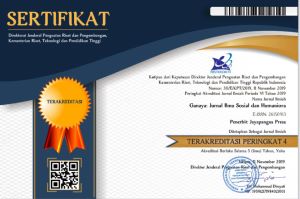Strategi Kreatif Produser Buser Investigasi Liputan6 SCTV
DOI:
https://doi.org/10.37329/ganaya.v8i3.4520Keywords:
Strategy, Creativity, Television Production, Digital Media, Buser InvestigationAbstract
Buser Investigasi Liputan6 SCTV faces a major challenge in maintaining the existence and relevance of its programs amidst the shift in audience preferences towards digital platforms such as YouTube, Instagram, and TikTok. Nielsen March 2023, provided a research that from December 2022 to February 2023, Television always got a number of viewers with a portion that was not larger than cable TV and streaming media, which was around 24.2%. This condition requires television producers to implement innovative creative strategies, not only in presenting news but also in choosing themes, production techniques, and utilizing social media to reach a wider and more diverse audience. The purpose of this study is to examine and analyze what creative strategies are carried out by Buser Investigasi producers and what challenges the producers will face. This study uses a qualitative approach of a qualitative descriptive type in the research period carried out by researchers for 3 months starting from March 2025 to May 2025, by interviewing two producers and one head of a special program. The data collection technique in this study is observation by observing the results of the broadcast, in-depth interviews, and documentation. In data analysis, researchers used data analysis according to Miles & Huberman with three main flows, namely data reduction, data presentation & drawing conclusions. The strategies that have been created and implemented by Buser Investigasi producers include determining the theme, approaching sources, scripts, intonation, editing, and utilizing digital platforms. In this study, it was found that Buser Investigasi producers can apply creative strategies well and on target.
References
Ardoyo, N. A. W. (2018). Pengaruh Program 86 Net Tv Terhadap Sikap Penonton. Jurnal Pustaka Komunikasi, 1(1), 147–154.
Effendy, O. U. (1993). Televisi Siaran: Teori dan Praktek. Bandung: Mandar Maju.
Fathon, G. A., Topadang, A., & Syafrizal, A. (2025). Pembuatan Film Pendek “Kebahagiaan Sesaat” Menggunakan Teknik Color Grading Pada Editing Untuk Menambah Kesah Dramatisasi Dalam Cerita. JATI: Jurnal Mahasiswa Teknik Informatika, 9(4), 7128–7135.
Karunia H, H., Ashri, N., & Irwansyah, I. (2021). Fenomena Penggunaan Media Sosial : Studi Pada Teori Uses and Gratification. Jurnal Teknologi Dan Sistem Informasi Bisnis, 3(1), 92–104.
Laksono, D. D. (2010). Jurnalisme Investigasi. Bandung: Kaifa.
Lokananta, A. C., Lestari, R., Wicaksono, B., & Elizabeth. (2024). Producer ’ S Strategy in Improving Broadcast. Jurnal Ilmu Komunikasi UHO : Jurnal Penelitian Kajian Ilmu Sosial Dan Informasi, 9(1), 121–135.
M, N. C. I. (2024). Pergeseran Preferensi Menonton dan Transformasi Media Digital di Indonesia Akibat Dominasi Netflix. JEMSI: Jurnal Ekonomi Manajemen Sistem Informasi, 6(2), 550–555.
Millerson, G. (1999). Television Production. New York: Focal Press.
Morissan, M. I. (2018). Manajemen media penyiaran: Strategi mengelola radio & televisi. Jakarta: Prenada Media.
Murtiadi. (2019). Strategi Kreatif Produser Dalam Mempertahankan Eksistensi Program Mission X Transtv. J-Ika: Jurnal Ilmu Komunikasi, 6(1), 11–23.
Octaviani, R. (2019). Strategi Kreatif Produser Program Berita Liputan 6 SCTV Dalam Meningkatkan Kualitas (Universitas Ahmad Dahlan). Universitas Ahmad Dahlan.
Prasetyawati, H., & Karmelin, F. (2022). Proses Produksi Program Talkshow “Prime Talk” di Metro TV. Inter Komunika: Jurnal Komunikasi, 7(1), 35–58.
Ridwan, N., & Darmawan, Z. S. (2023). Strategi Produser dalam Mempertahankan Eksistensi Program Buser SCTV. Journal Syntax Idea, 5(8), 1859–1867.
Rinidji, A. P., & Hidayat, D. (2024). Perubahan Perilaku Masyarakat Dalam Menghadapi Transformasi Digital Dalam Penyiaran Televisi (Studi Kasus Mengenai Kebiasaan Baru Masyarakat Di Desa Cingcin Dalam Menyikapi Digitalisasi Penyairan Televisi). Professional: Jurnal Komunikasi Dan Administrasi Publik, 11(1), 167–176.
Sarifah, S., & Purwanto. (2020). Jurnalisme investigasi televisi di Kompas TV Jakarta (Studi analisis isi kuantitatif pada naskah berita “Berkas Kompas”). Rekam: Jurnal Fotografi, Televisi, Animasi, 16(2).
Sarmiati, E. R. R. (2019). Komunikasi Interpersonal. Malang: CV IRDH.
Sholihah, A. (2021). Strategi Kreatif Produser Hafiz Indonesia RCTI. Jurnal At-Taghyir: Jurnal Dakwah Dan Pengembangan Masyarakat Desa, 3(2), 321–340.
Sitorus, C. N., Yurens, T., & Isbimayanto. (2022). Gatekeeping dalam Produksi Berita pada Halaman Utama di Media Cetak Harian Disway. RELASI: Jurnal Penelitian Komunikasi, 2(3), 20–27.
Sugiyono. (2017). Metode Penelitian Kuantitatif, Kualitatif, dan R&D (26th ed.). Bandung: CV Alfabeta.
te Walvaart, M., Dhoest, A., & Van den Bulck, H. (2019). Production Perspectives on Audience Engagement: Community Building for Current Affairs Television. Media Industries Journal, 6(1).
Zartian, M. M. G., & Maring, P. (2021). Strategi Kreatif Produser dalam Mempertahankan Eksistensi Acara Top Files di Stasiun Televisi iNews. Jurnal Pewarta Indonesia, 3(1), 12–18.
Downloads
Published
How to Cite
Issue
Section
License
Copyright (c) 2025 Andre Ginting, Machyudin Agung Harahap (Author)

This work is licensed under a Creative Commons Attribution-ShareAlike 4.0 International License.
An author who publishes in the Ganaya : Jurnal Ilmu Sosial dan Humaniora agrees to the following terms:
- Author retains the copyright and grants the journal the right of first publication of the work simultaneously licensed under the Creative Commons Attribution-ShareAlike 4.0 License that allows others to share the work with an acknowledgement of the work's authorship and initial publication in this journal
- Author is able to enter into separate, additional contractual arrangements for the non-exclusive distribution of the journal's published version of the work (e.g., post it to an institutional repository or publish it in a book) with the acknowledgement of its initial publication in this journal.
- Author is permitted and encouraged to post his/her work online (e.g., in institutional repositories or on their website) prior to and during the submission process, as it can lead to productive exchanges, as well as earlier and greater citation of the published work (See The Effect of Open Access).
Read more about the Creative Commons Attribution-ShareAlike 4.0 Licence here: https://creativecommons.org/licenses/by-sa/4.0/.








